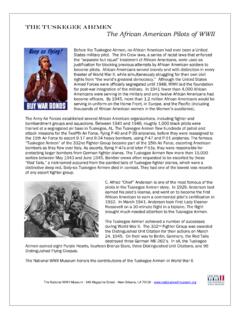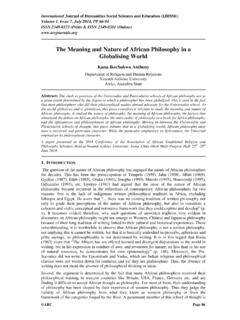Transcription of African Americans in World War II Fighting for a Double ...
1 African Americans in World War II Fighting for a Double Victory African Americans served bravely and with distinction in every theater of World War II, while simultaneously struggling for their own civil rights from the World s greatest democracy. Although the United States Armed Forces were officially segregated until 1948, WWII laid the foundation for post-war integration of the military. In 1941 fewer than 4,000 African Americans were serving in the military and only twelve African Americans had become officers. By 1945, more than million African Americans would be serving in uniform on the Home Front, in Europe, and the Pacific (including thousands of African american women in the Women s auxiliaries). During the war years, the segregation practices of civilian life spilled over into the military.
2 The draft was segregated and more often than not African Americans were passed over by the all-white draft boards. Pressure from the NAACP led President Roosevelt to pledge that African Americans would be enlisted according to their percentage in the population. Although this percentage, , was never actually attained in the services during the war, African american numbers grew dramatically in the Army, Navy, Army Air Force, Marine Corps, and the Coast Guard. While most African Americans serving at the beginning of WWII were assigned to non-combat units and relegated to service duties, such as supply, maintenance, and transportation, their work behind front lines was equally vital to the war effort. Many drove for the famous Red Ball Express, which carried a half million tons of supplies to the advancing First and Third Armies through France.
3 By 1945, however, troop losses virtually forced the military to begin placing more African american troops into positions as infantrymen, pilots, tankers, medics, and officers in increasing numbers. In all positions and ranks, they served with as much honor, distinction, and courage as any american soldier did. Still, African american MPs stationed in the South often could not enter restaurants where their German prisoners were being served a meal. On D-Day, the First Army on Omaha and Utah Beaches included about 1,700 African american troops. This number included a section of the 327th Quartermaster Service Company and the 320th Anti-Aircraft Barrage Balloon Battalion, which protected troops on the beach from aerial attack.
4 Soon the all-black 761st Tank Battalion was Fighting its way through France with Patton s Third Army. They spent 183 days in combat and were credited with capturing 30 major towns in France, Belgium, and Germany. The Army Air Force also established several African american fighter and bomber groups. The famous Tuskegee Airmen of the 332nd Fighter Group became part of the 15th Air Force, flying ground support missions over Anzio and escorting bombers on missions over Southern Italy. The Tuskegee Airmen flew more than 15,000 sorties May 1943 and June 1945. Bomber crews often requested to be escorted by these Redtails, a nicknamed acquired from the painted tails of Tuskegee fighter planes. Sixty-six Tuskegee Airmen died in combat. Stephen Ambrose identified the lamentable american irony of WWII, writing, The World s greatest democracy fought the World s greatest racist with a segregated army (Ambrose, Citizen Soldier).
5 During the global conflict, African american leaders and organizations established the Double V campaign, calling for victory against the enemy overseas and victory against racism at home. This new black consciousness and the defiant rejection of unjustifiable racism planted important seeds for the post-War civil rights movement. The National WWII Museum honors the contributions of African Americans in World War II. The National WWII Museum 945 Magazine Street New Orleans, LA 70130












